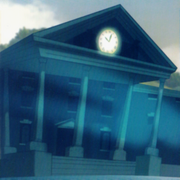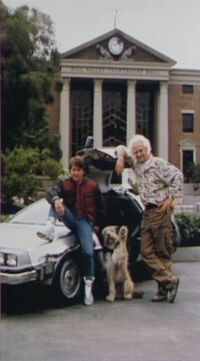- "Ladies and gentlemen, as mayor of Hill Valley, it gives me great pleasure to dedicate this clock to the people of Hill County. May it stand for all time!"
- —Mayor Hubert, September 5, 1885
Marty looks up at the courthouse clock in 1955.
The Hill Valley Courthouse and Clock Tower, also known as the Hill County Courthouse was a structure in Courthouse Square in Hill Valley, California.
Description
Hill Valley Courthouse
The Hill Valley Courthouse and clock tower were of a common construction and architectural style seen across the United States in the 1800s and 1900s. It was composed of red brick, concrete, and white trim. Two black cougar statues flanked the clock. The clock dial used "IV" for the number four, instead of "IIII" which is usually found on clocks with Roman numerals (except for Big Ben in London). On each quarter hour, the clock would chime.
History
The courthouse underwent several changes over the course of its 130-year history. It was first constructed in 1885. On September 3, 1885, it almost experienced its first hanging by Buford Tannen before Dr. Emmett Brown intervened. A ceremony held during the September 5th Hill Valley Festival started the clock at 8:00 pm. It would be completed the following year alongside the Shonash Ravine Bridge project.
From the 1880s until at least the 1950s, the building was the county courthouse with a lush lawn with walking paths that led from the building to the corners of the block.
The courthouse was used as a shelter during the San Francisco Earthquake during 1906.[1]
Up until some point in 1929, there was a ladder leading up to the top of the Courthouse, but it was removed due to some jumping incidents.[2]
In 1931 when Emmett was 17 he worked at the courthouse as a junior clerk with his father as the judge at the time. Also before Marty McFly went back to June 13, 1931 to find him while he was in Edna Strickland's apartment he sees a picture of him dead on the steps of the courthouse in a newspaper (while looking for the date that he was stuck in back in the past).
On August 25, 1931, Einstein was stranded on the roof of the Courthouse after riding Emmett's rocket-powered car. He was saved by Doc shortly after.
On October 12, 1931, Emmett was sulking at the top of the Courthouse. After a lightning strike, he got tangled on a rope tied to the statue, only to be saved by Marty. On the night after, Marty would run into Arthur McFly and Trixie Trotter before leaving 1931.
Shortly after discovering Doc's grave in 1955, the duo head to a library containing historical documents which by a large establishing shot, holds a large resemblance to the inside of the courthouse [Back to the Future 3, 15 minutes and 15 seconds in]. The space is fronted by three stories of windows similar to the placement, shape, and style of the windows on the façade of the courthouse. The marble floored atrium is flanked by two wood trimmed stairwells leading to halls on either side. The library sits in the middle. If this is indeed the courthouse, it is one of two times the main interior is shown in the movies [Back to the Future 2, 20 minutes and 58 seconds in].
The clock tower was struck by lightning during an electrical storm on November 12, 1955. This fused the clock's internal mechanism and had stopped the clock at 10:04 pm permanently. Despite efforts trying to repair or replace the damaged clockwork, the Hill Valley Preservation Society kept it in this condition as part of the town's history and heritage. Though the courthouse's lightning rod could provide sufficient electrical grounding to absorb lightning strikes, it had completely severed. Originally, the tower was simply struck by lightning and the clock rendered useless, but after Marty visited 1955, a experiment involving hooking a cable up to the antenna was created by Doc to send Marty back to the future.
Over time, many unsuccessful efforts were put into place to replace the clock tower from the current mayor in office.
In 1985, the Department of Social Services occupied the building, and the lawn had been replaced by a parking lot.
In 1985A, the courthouse had been turned into Biff Tannen's Pleasure Paradise Casino & Hotel, with over twenty-seven floors. This was undone in 1985B after Marty burned the Grays Sports Almanac in 1955 using a matchbook he had taken from the Pleasure Paradise.
In an alternate 1986 where Hill Valley is a repressed dystopia, the clock tower has become Citizen Brown's monument to cold efficiency and order. Marty crashes the DeLorean into a billboard showing Citizen Brown embracing the clock tower. Brown's office is located in the room directly behind the clock face. In this timeline the clock is actually functioning, meaning that in this timeline, First Citizen Brown promptly repaired the damage done by the lightning strike in order to maintain his symbol of efficiency.

The new clock tower in 1990.
In 1990, in the revised timeline, a new clock was installed on the Hill Valley Courthouse, despite efforts from the Hill Valley Preservation Society.

The 2015 courthouse and its large, futuristic-looking darkened windows form the background of this publicity shot of Michael J. Fox, Christopher Lloyd and Freddie posing with the DeLorean time machine on the set of Back to the Future Part II.
In 2015, in the original timeline, the courthouse had large darkened windows at the front and had become a shopping mall with underground shops with a lush garden and a decorative pond in the courtyard. The clock, however, was still non-functional after sixty years. On October 21, Griff Tannen and his gang were chasing Marty through the town square on hoverboards, believing him to be his future son Marty Jr. They ended up crashing into the building, which resulted in the gang being arrested and thus preventing the robbery that would've put Marty Jr. in jail.






